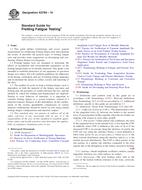Potřebujeme váš souhlas k využití jednotlivých dat, aby se vám mimo jiné mohly ukazovat informace týkající se vašich zájmů. Souhlas udělíte kliknutím na tlačítko „OK“.
ASTM E2789-10
Standard Guide for Fretting Fatigue Testing
Automaticky přeložený název:
Standardní příručka pro vztekat únavové zkoušky
NORMA vydána dne 1.11.2010
Informace o normě:
Označení normy: ASTM E2789-10
Poznámka: NEPLATNÁ
Datum vydání normy: 1.11.2010
Kód zboží: NS-46039
Počet stran: 10
Přibližná hmotnost: 30 g (0.07 liber)
Země: Americká technická norma
Kategorie: Technické normy ASTM
Anotace textu normy ASTM E2789-10 :
Keywords:
fretting, fatigue, slip, sliding, ICS Number Code 77.040.10 (Mechanical testing of metals)
Doplňující informace
| Significance and Use | ||||||||||||||||||||||
|
Fretting fatigue tests are used to determine the effects of several fretting parameters on the fatigue lives of metallic materials. Some of these parameters include differing materials, relative displacement amplitudes, normal force at the fretting contact, alternating tangential force, the contact geometry, surface integrity parameters such as finish, and the environment. Comparative tests are used to determine the effectiveness of palliatives on the fatigue life of specimens with well-controlled boundary conditions so that the mechanics of the fretting fatigue test can be modeled. Generally, it is useful to compare the fretting fatigue response to plain fatigue to obtain knockdown or reduction factors from fretting fatigue. The results may be used as a guide in selecting material combinations, design stress levels, lubricants, and coatings to alleviate or eliminate fretting fatigue concerns in new or existing designs. However, due to the synergisms of fatigue, wear, and corrosion on the fretting fatigue parameters, extreme care should be exercised in the judgment to determine if the test conditions meet the design or system conditions. For data to be comparable, reproducible, and correlated amongst laboratories and relevant to mimic fretting in an application, all parameters critical to the fretting fatigue life of the material in question will need to be replicated. Because alterations in environment, metallurgical properties, fretting loading (controlled forces and displacements), compliance of the test system, etc. can affect the response, no general guidelines exist to quantitatively ascertain what the effect will be on the specimen fretting fatigue life if a single parameter is varied. To assure test results can be correlated and reproduced, all material variables, testing information, physical procedures, and analytical procedures should be reported in a manner that is consistent with good current test practices. Because of the wear phenomenon involved in fretting, idealized contact conditions from which the fretting contact area and pressure may be calculated exist only at the onset of the test. Although it is still possible to calculate an average fretting pressure using the initial contact area, the pressure within the contact area may vary considerably. Results of the fretting fatigue tests may be suitable for application to design when the test conditions adequately mimic the design service conditions. |
||||||||||||||||||||||
| 1. Scope | ||||||||||||||||||||||
|
1.1 This guide defines terminology and covers general requirements for conducting fretting fatigue tests and reporting the results. It describes the general types of fretting fatigue tests and provides some suggestions on developing and conducting fretting fatigue test programs. 1.2 Fretting fatigue tests are designed to determine the effects of mechanical and environmental parameters on the fretting fatigue behavior of metallic materials. This guide is not intended to establish preference of one apparatus or specimen design over others, but will establish guidelines for adherence in the design, calibration, and use of fretting fatigue apparatus and recommend the means to collect, record, and reporting of the data. 1.3 The number of cycles to form a fretting fatigue crack is dependent on both the material of the fatigue specimen and fretting pad, the geometry of contact between the two, and the method by which the loading and displacement are imposed. Similar to wear behavior of materials, it is important to consider fretting fatigue as a system response, instead of a material response. Because of this dependency on the configuration of the system, quantifiable comparisons of various material combinations should be based on tests using similar fretting fatigue configurations and material couples. 1.4 This standard does not purport to address all of the safety concerns, if any, associated with its use. It is the responsibility of the user of this standard to establish appropriate safety and health practices and determine the applicability of regulatory limitations prior to use. |
||||||||||||||||||||||
| 2. Referenced Documents | ||||||||||||||||||||||
|




 Cookies
Cookies
